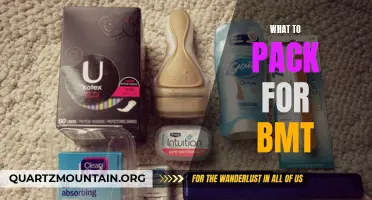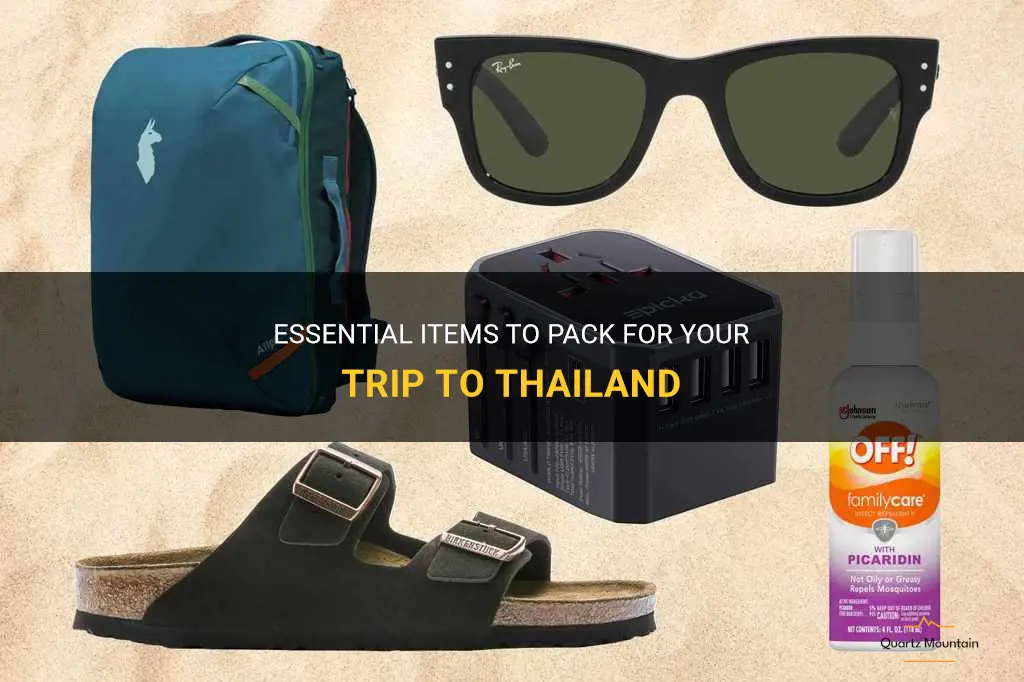
Thailand, a Southeast Asian gem known for its vibrant culture, stunning beaches, and delicious street food, is a popular destination for travelers worldwide. Planning a trip to this tropical paradise requires careful packing to ensure a smooth and enjoyable experience. From sun protection essentials to cultural appropriateness, there are a few must-have items that should not be missed when preparing for your unforgettable journey to Thailand.
| Characteristics | Values |
|---|---|
| Weather | Hot and Humid |
| Clothing | Lightweight and breathable |
| Shoes | Sandals and comfortable walking shoes |
| Sun Protection | Sunscreen and hats |
| Insect Repellent | Mosquito repellent |
| Medications | Basic first aid kit and any necessary prescriptions |
| Electronic Devices | Universal plug adapter and portable charger |
| Documents | Passport and copies, travel insurance |
| Money | Thai Baht and credit/debit cards |
| Toiletries | Travel-sized toiletries and toilet paper |
| Transportation | Travel itinerary and maps/guides |
| Entertainment | Books, e-books, or other forms of entertainment |
| Snacks/Refreshments | Bottled water and non-perishable snacks |
| Language and Culture | Phrasebook or language translation app, cultural knowledge |
| Safety | Travel lock, emergency contact information |
| Miscellaneous | Camera, sunglasses, travel pillow |
What You'll Learn
- What essential clothing items should I pack for a trip to Thailand?
- What kind of footwear is recommended for exploring Thailand's cities and beaches?
- Are there any specific items or accessories that are necessary for temple visits in Thailand?
- What kind of insect repellent should I bring to protect against mosquitoes and other bugs in Thailand?
- Is there anything else besides clothing and toiletries that I should pack for a trip to Thailand, such as adapters or voltage converters?

What essential clothing items should I pack for a trip to Thailand?
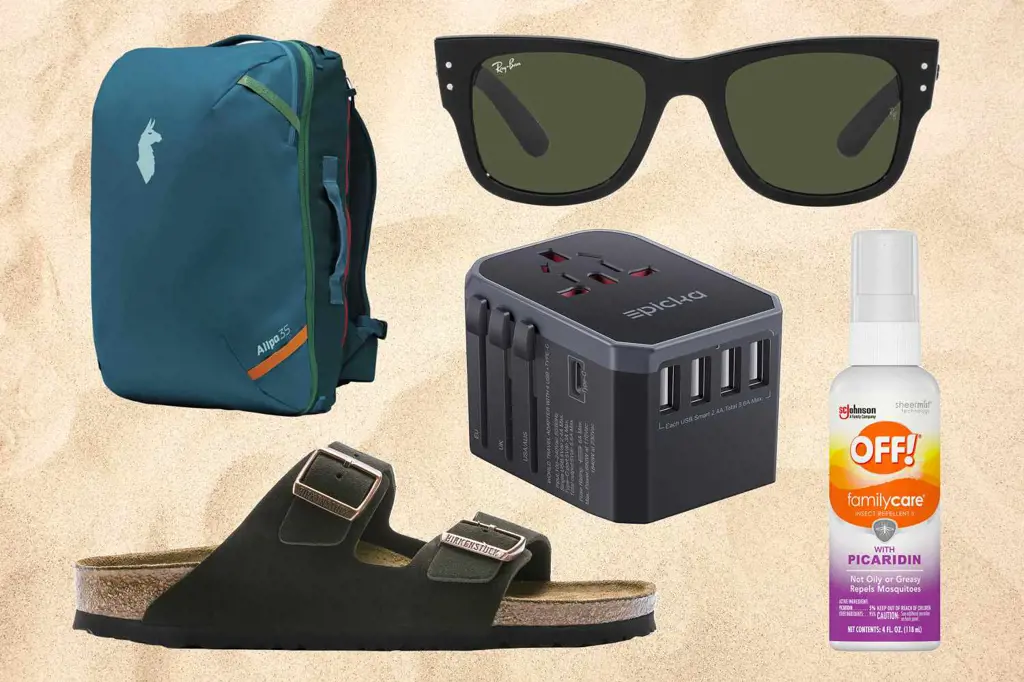
When planning a trip to Thailand, it's important to pack the right clothing to ensure you stay comfortable in the country's tropical climate. Here are some essential clothing items that you should pack for your trip:
- Lightweight and breathable clothing: Thailand is known for its hot and humid weather, so packing lightweight and breathable clothing is essential. Opt for loose-fitting shirts and shorts made from natural fabrics such as cotton or linen. Avoid heavy materials like denim, as they can be uncomfortable in the heat.
- Swimwear: Thailand is home to beautiful beaches and stunning islands, so be sure to pack your swimwear. Whether you're planning to relax on the sand or go snorkeling in crystal clear waters, having a swimsuit is a must. Additionally, many hotels and resorts in Thailand have pools, so you might want to pack an extra swimsuit for lounging by the poolside.
- Sarong or lightweight scarf: In Thailand, it's common to visit temples and other religious sites, where it's necessary to cover your shoulders and knees as a sign of respect. Packing a sarong or a lightweight scarf is essential to ensure that you can easily cover up when needed. Sarongs can also double as a beach cover-up or a picnic blanket.
- Comfortable shoes: Thailand offers plenty of opportunities for exploring, whether it's walking through bustling markets, trekking in the mountains, or visiting cultural sites. Make sure to pack comfortable shoes that are suitable for walking. Avoid open-toed sandals as they can be uncomfortable or impractical in certain situations. Instead, opt for lightweight sneakers or breathable hiking shoes.
- Hat and sunglasses: With Thailand's intense sunshine, it's important to protect yourself from the harmful rays. Pack a wide-brimmed hat to shield your face and neck from the sun. A pair of sunglasses is also essential to protect your eyes and make your outdoor adventures more enjoyable.
- Light jacket or sweater: While Thailand is generally hot, evenings and air-conditioned places can sometimes feel chilly. Packing a light jacket or sweater can come in handy when you need a little extra layer to stay comfortable.
- Insect repellent: Thailand is known for its mosquitoes and other insects. To protect yourself from bug bites and prevent diseases such as dengue fever, packing insect repellent is crucial. Look for a repellent that contains DEET or other recommended ingredients for maximum effectiveness.
- Modest clothing for temple visits: As mentioned earlier, it's important to dress modestly when visiting temples in Thailand. Women should avoid wearing low-cut tops, sleeveless shirts, or skirts that are above the knee. Men should avoid wearing shorts that are too short or tank tops. Having a few modest outfits in your luggage will ensure you can explore the country's cultural sites without any issues.
In conclusion, packing the right clothing for a trip to Thailand is essential for staying comfortable in the country's tropical climate. Remember to pack lightweight and breathable clothing, swimwear, a sarong or lightweight scarf for temple visits, comfortable shoes for exploring, a hat and sunglasses for sun protection, a light jacket or sweater for cooler evenings, insect repellent, and modest clothing for temple visits. By packing these essential items, you'll be well-prepared for your adventures in Thailand.
Essential Items to Pack for a Relaxing Cruise Vacation
You may want to see also

What kind of footwear is recommended for exploring Thailand's cities and beaches?
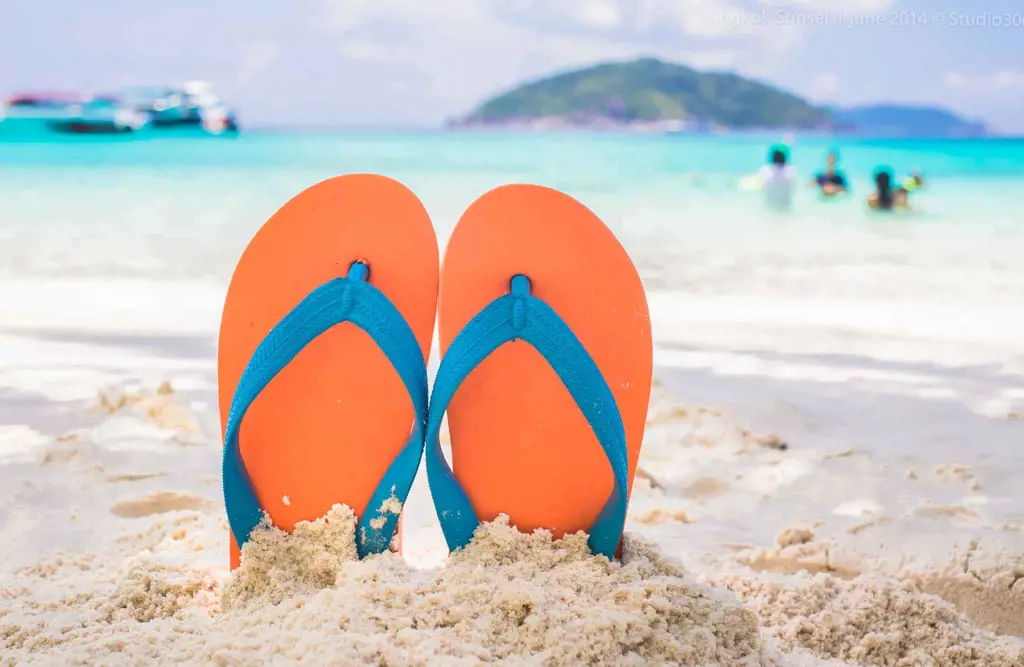
When planning to explore Thailand's cities and beaches, it is important to consider what kind of footwear will be suitable for your activities. The right choice of footwear can make your experience more comfortable and enjoyable, while also protecting your feet from the various terrains and climates you may encounter.
Thailand is known for its diverse landscapes, ranging from bustling cities to pristine beaches and lush jungles. Each of these environments requires different types of footwear to ensure your feet are well-supported and protected.
In cities such as Bangkok, where you will likely be doing a lot of walking on pavements and city streets, it is recommended to wear comfortable walking shoes or sneakers. The streets can be crowded and uneven, so having footwear with good cushioning and support is important. Breathable materials are also ideal, as the weather in Thailand can get hot and humid, and you don't want your feet to overheat.
When heading to the beaches and islands, it is essential to have a pair of sandals or flip flops. These will allow you to easily transition from the sandy shores to the clear blue waters. Opt for sandals with straps that secure your feet for added stability, especially if you plan on engaging in water activities such as snorkeling or swimming. It is important to note that some of the beaches in Thailand may have sharp rocks or coral reefs, so it is wise to choose sandals with thicker soles to protect your feet.
If you plan on exploring the jungles and national parks of Thailand, sturdy hiking boots or trekking shoes are highly recommended. The terrains can be challenging, with uneven surfaces, muddy trails, and potential encounters with wildlife. Hiking boots with good traction and ankle support will help prevent slips and provide stability on slippery or rocky paths. They will also offer protection against any thorns or sharp objects that may be on the ground.
It is also important to consider the weather conditions when choosing footwear for exploring Thailand. Thailand has three main seasons: hot, cool, and rainy. During the hot season, breathable and lightweight footwear is essential to keep your feet cool and prevent discomfort. In the cool season, it may be necessary to bring a pair of closed-toe shoes or boots to keep your feet warm, especially in the mountains or during cooler evenings. And during the rainy season, it is a good idea to have waterproof footwear or at least quick-drying sandals to navigate through the occasional downpours and flooded streets.
To summarize, when exploring Thailand's cities and beaches, it is recommended to have a variety of footwear options to suit different activities and terrains. Comfortable sneakers or walking shoes are ideal for city exploration, while sandals or flip flops are essential for beach visits. Sturdy hiking boots or trekking shoes are necessary for jungle adventures. Consider the weather conditions and choose footwear that is breathable, lightweight, waterproof, or heat-resistant accordingly. By choosing the right footwear, you can ensure a comfortable and safe exploration of all that Thailand has to offer.
Essential Items to Pack for a Fun-Filled Weekend in Austin
You may want to see also

Are there any specific items or accessories that are necessary for temple visits in Thailand?
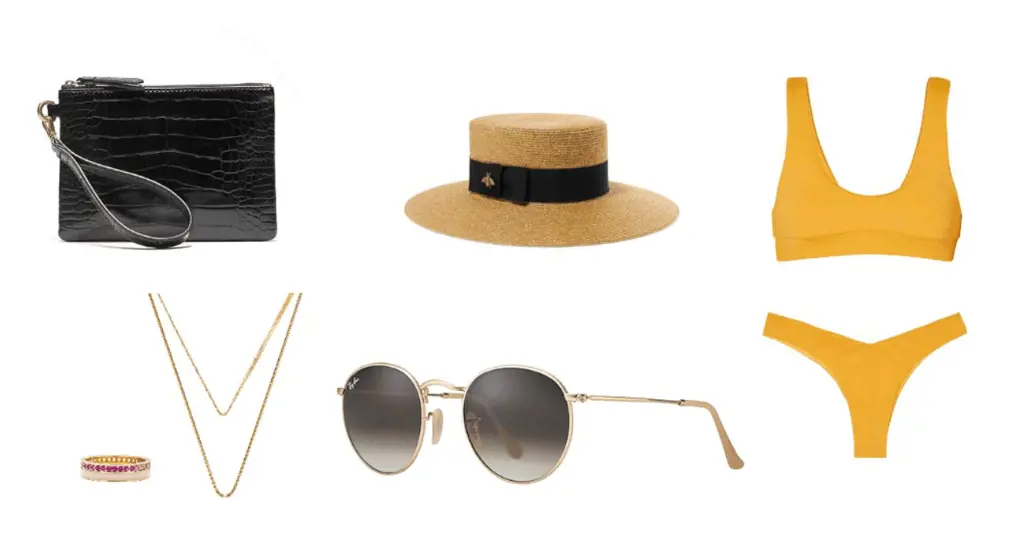
When visiting temples in Thailand, there are a few specific items and accessories that are necessary to ensure a respectful and appropriate experience. These items not only help adhere to local customs and traditions but also promote personal comfort and safety throughout the visit. Here are some essential items to bring along when visiting temples in Thailand.
- Modest Clothing: When entering a temple, it is crucial to dress appropriately and modestly as a sign of respect. Both men and women should ensure their shoulders, knees, and midriffs are covered. Loose-fitting, comfortable clothing made of lightweight fabric is ideal, as Thailand can have hot and humid weather year-round.
- Sarong or Scarf: It may be necessary to wrap a sarong or scarf around your waist or shoulders to cover any exposed skin. This is particularly important if you are wearing shorts or sleeveless tops. Some temples may provide sarongs for visitors to borrow, but it is advisable to bring your own to guarantee availability.
- Comfortable Shoes: Exploring temples often involves a lot of walking and climbing stairs, so it's important to wear comfortable shoes. Opt for closed-toe shoes with good grip to navigate uneven terrain and stairs.
- Sun Protection: Thailand has a tropical climate, so it's essential to protect yourself from the sun's harsh rays. Bring a hat or a lightweight scarf to shield your head and face, as well as sunscreen with a high SPF to protect your exposed skin from sunburn.
- Insect Repellent: Mosquitoes and other insects can be prevalent around temple grounds, especially in the evening. Apply an insect repellent containing DEET to keep mosquitoes at bay and avoid any discomfort or potential diseases from bites.
- Small Bag or Backpack: A small-sized bag or backpack is useful for carrying your essential items like water, snacks, and a camera. Ensure the bag is lightweight and easy to carry, as you will likely be moving around a lot while exploring the temple complex.
- Drinking Water: Staying hydrated is crucial, especially in the hot and humid weather of Thailand. Bring a water bottle to keep yourself hydrated during your visit to the temple. Some temples may have water fountains or vendors selling bottled water, but it's always a good idea to have your own supply.
- Camera or Smartphone: To capture the beautiful architecture, statues, and serene ambiance of the temples, bring a camera or use the camera on your smartphone. But remember to be respectful and abide by any restrictions on photography within the temple grounds.
- Cash: Some temples may require an entrance fee or request donations. It's a good idea to bring some cash in small denominations to cover any necessary payments or offerings you may wish to make.
- Respectful Attitude: Lastly, the most important accessory when visiting temples in Thailand is a respectful attitude. Temples are sacred places, and it's important to behave respectfully, keeping noise levels low and refraining from any disruptive or disrespectful behavior.
Overall, by keeping these essential items and accessories in mind, you can ensure a pleasant and respectful experience when visiting temples in Thailand. Remember to familiarize yourself with any specific temple guidelines or rules before your visit, as different temples may have variations in customs or dress codes.
Essential Items for a Memorable Camping Trip in Grand Teton National Park
You may want to see also

What kind of insect repellent should I bring to protect against mosquitoes and other bugs in Thailand?

When traveling to Thailand, it's important to take precautions to protect yourself against mosquitoes and other bugs that may carry diseases such as dengue fever or malaria. One of the most effective ways to do this is by using insect repellent. However, not all repellents are created equal, and it's important to choose the right one for your needs.
The first thing to consider when choosing an insect repellent is the active ingredient. DEET, picaridin, and oil of lemon eucalyptus are the most common active ingredients found in insect repellents. DEET is the most effective at repelling mosquitoes and other pests, but some people may be concerned about its potential side effects. Picaridin is a good alternative to DEET, as it is just as effective but has fewer potential side effects. Oil of lemon eucalyptus is a natural option that has been shown to be effective against mosquitoes, but it may not provide as long-lasting protection as DEET or picaridin.
The next thing to consider is the concentration of the active ingredient. Higher concentrations of DEET or picaridin will provide longer-lasting protection, but may also have a stronger odor and potentially irritate the skin. For most situations, a concentration of 10-30% DEET or 10-20% picaridin should be sufficient. However, if you will be spending a lot of time outdoors or in areas with a high mosquito population, you may want to consider a higher concentration.
It's also important to consider the form of the repellent. Sprays and lotions are the most common forms, but there are also repellent wipes and sticks available. Sprays are easy to apply and provide even coverage, but they may be more difficult to apply to the face. Lotions are easy to apply to all areas of the body, but they can leave a greasy residue. Wipes and sticks are convenient for on-the-go use, but may not provide as long-lasting protection as sprays or lotions.
Lastly, it's important to follow the instructions on the repellent's label. This includes applying the repellent evenly to exposed skin, avoiding contact with eyes and mouth, and reapplying as necessary. In general, repellents provide protection for a few hours, so it's important to reapply regularly, especially if you are sweating or swimming.
Overall, when choosing an insect repellent for your trip to Thailand, it's important to consider the active ingredient, concentration, form, and follow the instructions. By taking these precautions, you can help protect yourself against mosquitoes and other bugs and enjoy your time in Thailand without worry.
Exploring the Essentials: What to Pack for a Memorable Backpacking Adventure in Africa
You may want to see also

Is there anything else besides clothing and toiletries that I should pack for a trip to Thailand, such as adapters or voltage converters?
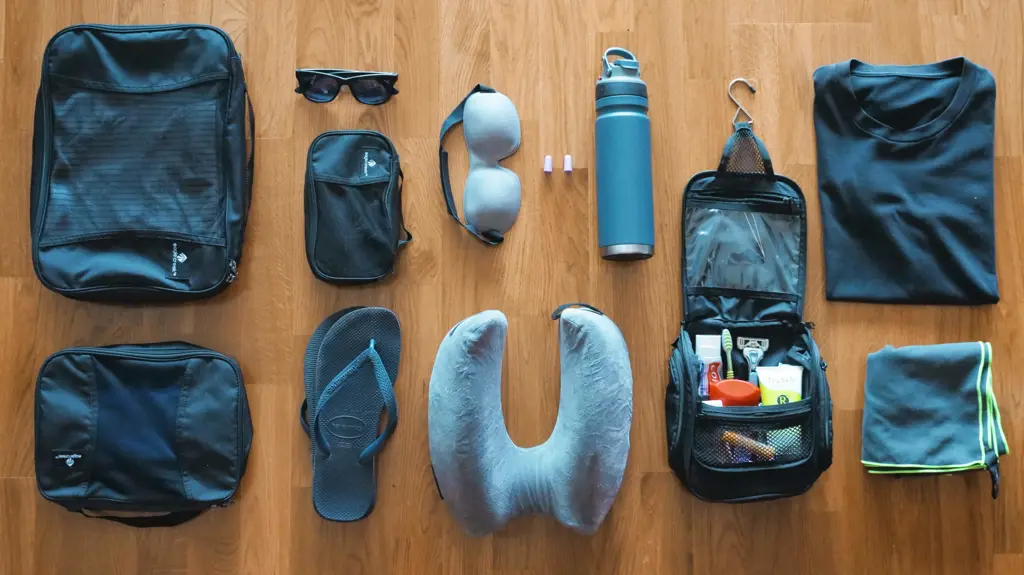
When preparing for a trip to Thailand, there are certainly a few items beyond clothing and toiletries that one should consider packing. These additional necessities can enhance your overall travel experience and ensure that you are fully prepared for any situations that may arise.
One essential item to bring is a power adapter or voltage converter. Thailand follows a different electrical system than many other countries, which means that your electronic devices may not be compatible with the local outlets. In Thailand, the standard voltage is 220V, and the frequency is 50Hz. Therefore, it is crucial to bring a power adapter that can convert your device's plug shape to fit the local outlets and also handle the voltage conversion if necessary. By having a power adapter, you can ensure that you can charge your devices and use them without any issues throughout your trip.
Another important item to pack for your trip to Thailand is a universal travel adaptor. This device is different from a power adapter or voltage converter as it does not convert the voltage, but rather allows you to plug in your electronic devices with different plug types into various outlets around the world. Since Thailand uses a different plug type (Type A/B/C/O), it is highly recommended to have a universal travel adaptor so that you can use your chargers and other electronic devices without any hassle.
Additionally, it is a good idea to bring a portable charger or power bank, especially if you plan on spending long hours exploring or engaging in outdoor activities. Having a portable charger will ensure that you can charge your devices on the go, without having to rely on finding electrical outlets or waiting for your devices to charge fully. This can be particularly useful when you are out and about, taking photos, using GPS navigation, or simply staying connected with friends and family.
In terms of safety, it is also advisable to pack a money belt or a secure travel wallet. These items can help protect your valuables such as passport, cash, and credit cards from pickpockets or accidental loss. Thailand is generally a safe country for travelers, but it is always better to be cautious and take precautions to avoid any potential mishaps.
Lastly, it may be worthwhile to invest in a pocket-sized phrasebook or download a translation app on your smartphone. While many popular tourist areas in Thailand have English-speaking locals, it can still be helpful to have some basic Thai phrases and words at your disposal. This can make it easier to communicate with locals, navigate transportation, or order food at local eateries. Learning a few key phrases can also show respect for the local culture and help you connect more with the people you encounter during your trip.
In summary, when packing for your trip to Thailand, in addition to clothing and toiletries, consider bringing a power adapter or voltage converter, a universal travel adaptor, a portable charger or power bank, a money belt or secure travel wallet, and a pocket-sized phrasebook or translation app. By making sure to pack these essential items, you can enhance your travel experience and ensure that you are prepared for any situation that may arise during your trip to beautiful Thailand.
The Essential Packing List for a Week in Southern Utah
You may want to see also
Frequently asked questions
When packing for a trip to Thailand, it's important to consider the climate and culture. Firstly, pack lightweight and breathable clothing such as shorts, t-shirts, and dresses, as Thailand can be warm and humid. It's also recommended to bring a hat and sunglasses to protect yourself from the sun. In terms of footwear, pack comfortable walking shoes or sandals, as you'll likely be doing a lot of exploring. Additionally, don't forget to pack a swimsuit and beach towel, as Thailand is home to beautiful beaches.
While Thailand is generally a relaxed and tolerant country, it's important to dress modestly in certain settings. Avoid wearing revealing or excessively tight clothing, especially when visiting temples or other religious sites. It's recommended to cover your shoulders and knees, so pack lightweight, loose-fitting pants or long skirts, as well as shirts that provide coverage. By dressing respectfully, you'll not only show cultural sensitivity but also feel more comfortable in the local environment.
In addition to clothing and footwear, there are a few other essential items to pack for a trip to Thailand. Firstly, pack a good quality insect repellent to protect yourself from mosquitoes, which are prevalent in certain areas. It's also a good idea to bring a reusable water bottle, as staying hydrated is important in the warm climate. Don't forget to pack sunscreen, as the sun can be strong, and a small first aid kit with essential medications and band-aids. Lastly, bring a power adapter compatible with Thai outlets, so you can charge your electronic devices.
When visiting temples or engaging in cultural activities in Thailand, it's important to respect local customs and traditions. Firstly, pack a sarong or lightweight scarf to cover your shoulders and legs when entering temples. This will ensure that you adhere to the dress code and show respect to the local culture. Additionally, bring a small bag to carry your shoes when necessary, as it's customary to remove footwear before entering certain sacred spaces. By packing these items, you'll be prepared for cultural experiences and able to fully immerse yourself in Thai traditions.





